Q&A – Ask Neil: March 21, 2024
(Please read these instructions carefully.)
Before you post your question, please look at recent issues to see if someone else has already asked it. You might find your answer there.
How to submit your question…
(Note: You may need to allow a pop-up window to come up in order to get the link for sending your photo(s). If you have already submitted your question and didn’t see the pop-up window, please click here.)
• Click the link provided below to post your question. After you submit your question, a new window will pop up giving you the address to which you can e-mail a SHARP, HIGH-RESOLUTION PHOTO to accompany your question. Please DO NOT SEND THUMBNAIL PHOTOS in case I need to zoom in to see things.
• Click here to post your question.
• Please ONLY POST YOUR QUESTION ONE TIME. We can only accept a set number of questions each week, and when we get duplicates it costs other people their chances.
• One question per reader, please.
• Please use this only for posting questions – not for standard emails.
• Watch for your answer in the following week’s e-gardens.
• I choose those of greatest general interest. For example, plant IDs seldom make the cut.
• I must have your first name or initials.
• I must have your city or county. (Texas is a very large state.)
QUESTION 1
WHY ARE SOME REDBUDS DEEPER IN COLOR THAN OTHERS?
Question: I have noticed that some of redbuds are pink, while others are much darker (purple-pink). Which variety has the darker colors? Martha S., Haltom City.
Answer: The one that is best known for its burgundy-colored flowers is ‘Oklahoma.’ It has glossy green leaves. Many of the purple-leafed types such as ‘Forest Pansy’ and the weeping ‘Ruby Falls,’ among others, also have the darker pigmentation. Do your homework ahead of time, but it’s always best to buy them in flower to be certain.
QUESTION 2
WHAT SHOULD WE DO WITH A DAMAGED TEXAS MOUNTAIN LAUREL?
Question: We have a Texas mountain laurel that was broken during the ice storm a few years ago when a live oak limb fell on it. My husband wants to leave it. I want to take it out because it’s so damaged. He says he will follow your suggestion. Martha D., Bulverde, Comal County.
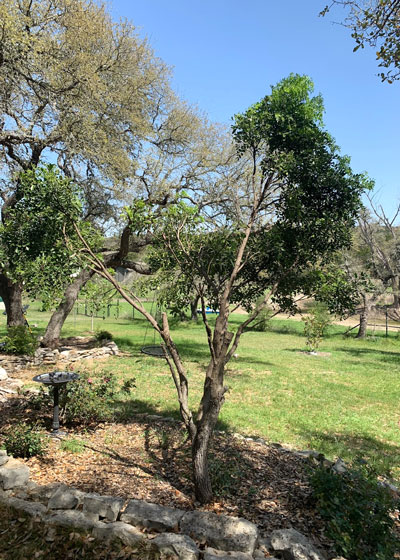
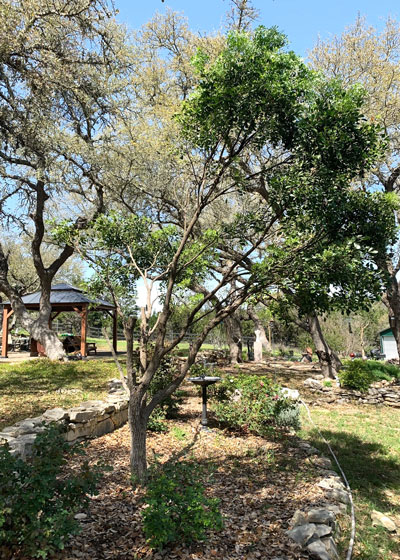
Answer: I value Texas mountain laurels, especially for your part of Texas. If I moved into your space, I would try cutting it back drastically for one growing season to see if it would sprout out with new shoots. I’d probably cut it back to where that one stub is on the right-hand trunk (left-hand photo), even though that would mean removing all the foliage. I just wish I could have answered this before it put on its flush of new growth for this spring. I would give it one year to start to fill back in. I might even buy a second one in a 7- or 10-gallon pot (or larger) to plant right alongside it to the left to let it take up some of the void. If all else fails, that could become your new plant.
QUESTION 3
WHY ARE SO MANY OF MY REDCEDAR TREES DYING?
Question: I live on 4.5 acres, and I have more than 40 native eastern redcedar junipers growing on it. Almost half of them are dying like the one in my photo. What is causing this? William M., Terrell.
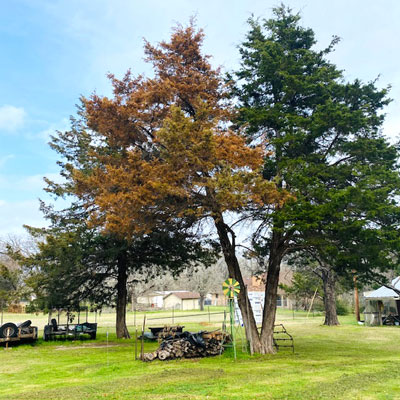
Answer: I have been asked this question many times this late winter and spring – more so than ever before in my 50-plus years of answering gardeners’ questions. And, I have seen 10 or 15 trees doing exactly what you have shown in your photo. They weren’t old trees, nor were they located where construction, farming, or other activities obviously would have put them at risk. So, my only clue was that they were dead without explanation. Top to bottom – all branches were dead at one time.
Spider mites attack eastern redcedars occasionally, but they turn the trees a lifeless olive-drab color, then tan. Your tree doesn’t look right for spider mites.
Bagworms can kill an entire eastern redcedar, but they leave bags hanging all over the tree. I see no bags, and this tree doesn’t look at all right for bagworms. None of the trees I saw in my travels had any bagworms at all.
Drought normally doesn’t impact eastern redcedars like this. That’s how they’ve survived to be called “natives.” I wouldn’t expect drought to have impacted one trunk out of two like you show in your photo. However, drought does weaken a tree, perhaps one trunk more than the other.
Finding nothing online to suggest any specific disease, especially any current “plague” that might be ravaging them, I reached out to my good friends (and advertisers) at Arborilogical Services. Russell Peters, himself a former Arborist of the Year for the entire state of Texas, also with a Master’s Degree in Plant Pathology from Texas A&M, says this might be an unusual occurrence of Seiridium canker, the disease that is much more common on other conifers like Leyland cypress and Italian cypress. Russ also mentioned the possibility that last year’s drought might have had an impact on your plants.
My suggestion at this point would be:
If the plants that were impacted in 2023 do not green up this spring (probably won’t), trim out all the dead wood. Disinfect your pruning tools with a 10-percent solution of chlorine bleach with water before you move on to the next branch. Oil the tools when you’re finished to prevent corrosion.
Send samples to the Plant Disease Lab at Texas A&M immediately if you have new damage starting to show up this year. They will be able to tell you if any type of pathogen was at work. Hopefully this won’t be needed.
I’m sorry to leave you hanging. Some questions just have more difficult answers.
QUESTION 4
WHAT IS THIS SOIL ISSUE WITH OUR BERMUDA LAWN?
Question: Please help us identify this soil issue in our bermuda lawn. There are patches of no growth. The patches have sharp edges. Nancy P., Weatherford.
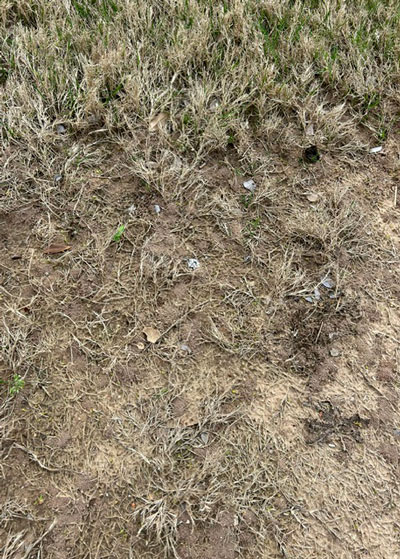
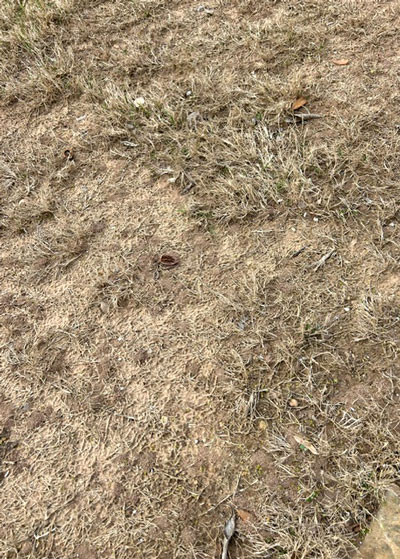
Answer: I would be surprised if this were due to a soil issue. Bermudagrass grows in cracks in highways where there is little, if any, soil. All I can see in the photos, unfortunately, is sandy looking topsoil and grass that is either brown and probably dead or grass that is just starting to green up.
I’ll list things that could be involved but be patient with me. I have absolutely no clues on which to base any of these possibilities. This could be due to excessive shade beneath trees. It might be because of a mis-applied weedkiller. It could be old damage from grub worms from late last fall, although we aren’t seeing nearly as much grub damage as we used to. There are diseases that attack bermuda, but I certainly can’t see them this many months removed from when they might have been happening. Or bermuda mites (probably not). Even pedestrian traffic from a dog or kids playing. I think you get the picture – I can’t tell from these photos. I’m sorry to have been of no help. (Please also see Question 7 and my answer to it.)
QUESTION 5
WHAT WOULD BE BEST REPLACEMENT FOR A CEDAR ELM?
Question: Please advise what tree I might use to replace a cedar elm that died. The area gets late afternoon shade from an oak across the street. The houses to the side have a pecan and oak. I’d like a multi-trunk tree and I like color. I was advised against river birch, which I like. I’ve been taking your advice for 51 years. Mary P., East Plano.
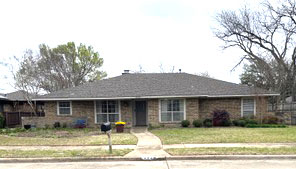
Answer: First things first, thanks for your confidence. And congratulations on your Plano East boys basketball team 6A State Champions!
River birches would not be a good choice for the Metroplex. Think of how many nice ones you see in your area that are more than 5 years old. I live in Collin County as you do, and I couldn’t show you one. They don’t tolerate our high temperatures, highly alkaline soils, or generally dry conditions.
If you want a multi-trunk tree with color, I would start looking for a nice balled-and-burlapped Shumard red oak. You want a tree that has been dug, because those clumps are made “by nature,” not “by man.” Plant it off center, slightly to the left of the small window near the left end of the house. If you decide to leave the bed where it is, plant it toward the outer edge of the bed. I would offset it with another tree planted farther out toward the sidewalk on the right side, perhaps about halfway between the tall red shrubs and the window. Having the two trees would give nice balance. That tree could be a live oak, bur oak, or Chinquapin oak.
QUESTION 6
WHY IS MY JAPANESE YEW TURNING BROWN?
Question: What is making the leaves of my Japanese yew turn brown? Jim P., Denison.
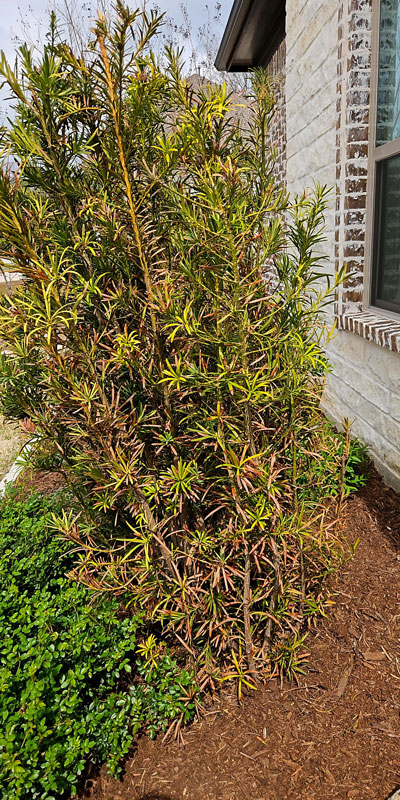
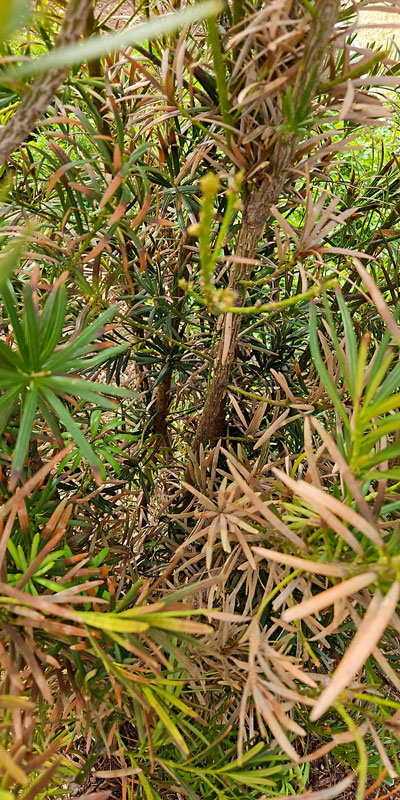
Answer: Cold damage. I’m amazed it survived the cold of February 2021. I’ve lost two plantings in McKinney, Collin County, just south of you over the years. We’re just too far north for them to be at all dependable. There are people who will argue, but your plant and mine stand as proof. I switched over to Oakland hollies. They have about the same growth form, yet they thrive in our area. They might fit your needs, too.
QUESTION 7
IS THERE A DISEASE IN SOIL THAT WOULD KILL OUR BERMUDA GRASS?
Question: Is there a local company that can assess our soil to determine why our bermudagrass is dying? Our service company says there is disease in the soil. It has gone on for several years. We need your advice. Jerry E., Garland.
Answer: I know this is essentially the same question as Q4, above, but I decided to leave it here so you could see that these things come up time after time.
Let me amplify on soil testing. Texas A&M has an outstanding soil testing laboratory to determine nutrient deficiencies, soluble salt contents, etc. Use them to determine what fertilizers you should and should not use.
I am asked occasionally if a lab can test for a contaminant that a vandal might have poured onto the ground. That is an expensive and time-consuming test. Whatever lab you employ must have some idea of what contaminant might be involved.
It’s almost impossible to take a bucket of soil and determine what mysterious chemical, be it herbicide, oil, gasoline, swimming pool chemicals, etc., might be present in that soil. It can be done, but at what cost!
And, as far as testing soil for presence of a disease, that’s usually going to be a dead end. Disease organisms require plant tissues to keep going. Pathologists test turf – its leaves, stolons, rhizomes, and roots for presence of funguses and bacteria. They might test the soil to see if nematodes were present, but nematodes aren’t commonly the cause of loss of turfgrass.
All of which is to say: to help you here in this setting, I need sharp and clear photos of turfgrass that is going downhill. I rarely need to see the soil, and seeing dead grass doesn’t help much. As much as I want to help, without that photographic evidence and details of shade/sun, when problems first started to show up (month), it’s almost impossible to give you an answer in which I have any confidence.
